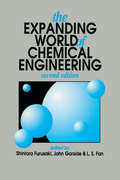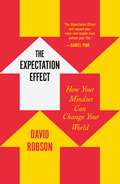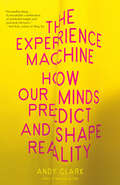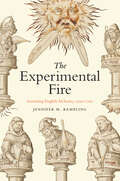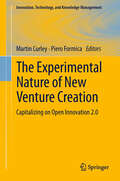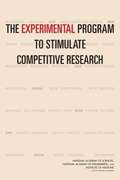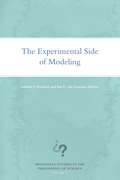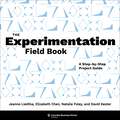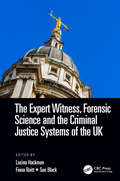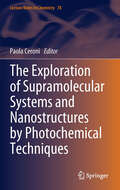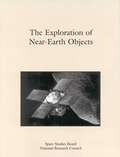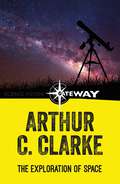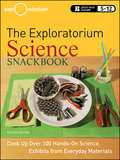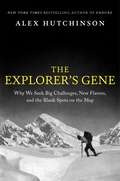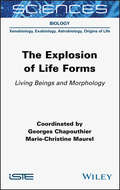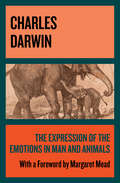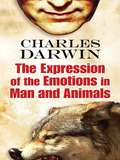- Table View
- List View
The Expanding Circle: Ethics, Evolution, and Moral Progress
by Peter SingerWhat is ethics? Where do moral standards come from? Are they based on emotions, reason, or some innate sense of right and wrong? For many scientists, the key lies entirely in biology--especially in Darwinian theories of evolution and self-preservation. But if evolution is a struggle for survival, why are we still capable of altruism? In his classic study The Expanding Circle, Peter Singer argues that altruism began as a genetically based drive to protect one's kin and community members but has developed into a consciously chosen ethic with an expanding circle of moral concern. Drawing on philosophy and evolutionary psychology, he demonstrates that human ethics cannot be explained by biology alone. Rather, it is our capacity for reasoning that makes moral progress possible. In a new afterword, Singer takes stock of his argument in light of recent research on the evolution of morality.
The Expanding Universe: A Primer on Relativistic Cosmology
by William D. HeacoxCosmology - the science of the Universe at large - has experienced a renaissance in the decades bracketing the turn of the twenty-first century. Exploring our emerging understanding of cosmology, this text takes two complementary points of view: the physical principles underlying theories of cosmology, and the observable consequences of models of Universal expansion. The book develops cosmological models based on fundamental physical principles, with mathematics limited to the minimum necessary to keep the material accessible for students of physics and astronomy at the advanced undergraduate level. A substantial review of general relativity leading up to the Einstein field equations is included, with derivations of explicit formulations connecting observable features of the Universe to models of its expansion. Self-contained and up to date in respect of modern observations, the text provides a solid theoretical grounding in modern cosmology while preparing readers for the changes that will inevitably come from future observations.
The Expanding World of Chemical Engineering
by S FurusakiThis new edition of The Expanding World of Chemical Engineering provides an overview of recent and future developments in chemical engineering and future aspects in chemical engineering. The book is written by leading researchers in various fields of expertise and covers most important topics in chemical engineering. The topics covered include; computer application, material design, supercritical fluid technology, colloid and powder technology, new equipment, bio and medical technology and environmental preservation and remediation. This is a valuable book for students at all levels as well as for practitioners in chemical engineering and industry.
The Expectation Effect: How Your Mindset Can Change Your World
by David Robson“As David Robson makes plain in this compelling book, the way we think about the world can profoundly shape how we navigate it. Based in science and packed with smart advice, The Expectation Effect will expand your mind—and maybe even extend your life.”—Daniel Pink, New York Times bestselling author of When, Drive, and To Sell Is HumanA journey through the cutting-edge science of how our mindset shapes every facet of our lives, revealing how your brain holds the keys to unlocking a better youWhat you believe can make it so.You’ve heard of the placebo effect and how sugar pills can accelerate healing. But did you know that sham heart surgeries often work just as well as placing real stents? Or that people who think they’re particularly prone to cardiovascular disease are four times as likely to die from cardiac arrest? Such is the power and deadly importance of the expectation effect—how what we think will happen changes what does happen.Melding neuroscience with narrative, science journalist David Robson takes readers on a deep dive into the many life zones the expectation effect permeates. We see how people who believe stress is beneficial become more creative when placed under strain. We see how associating aging with wisdom can add seven plus years to your life. People say seeing is believing but, over and over, Robson proves that the converse is truer: believing is seeing.The Expectation Effect is not woo-woo. You cannot think your way into a pile of money or out of a cancer diagnosis. But just because magical thinking is nonsense doesn’t mean rational magic doesn’t exist. Pointing to accepted psychology and objective physiology, Robson gives us the practical takeaways we need to improve our fitness, productivity, intelligence, and happiness. Any reader who wants to take their fate into their own hands need only pick up this book.
The Experience Machine: How Our Minds Predict and Shape Reality
by Andy ClarkA brilliant new theory of the mind that upends our understanding of how the brain interacts with the world&“This thoroughly readable book will convince you that the brain and the world are partners in constructing our understanding.&” —Sean Carroll, New York Times bestselling author of The Biggest Ideas in the Universe: Space, Time, and MotionFor as long as we&’ve studied human cognition, we&’ve believed that our senses give us direct access to the world. What we see is what&’s really there—or so the thinking goes. But new discoveries in neuroscience and psychology have turned this assumption on its head. What if rather than perceiving reality passively, your mind actively predicts it?Widely acclaimed philosopher and cognitive scientist Andy Clark unpacks this provocative new theory that the brain is a powerful, dynamic prediction engine, mediating our experience of both body and world. From the most mundane experiences to the most sublime, reality as we know it is the complex synthesis of sensory information and expectation. Exploring its fascinating mechanics and remarkable implications for our lives, mental health, and society, Clark nimbly illustrates how the predictive brain sculpts all human experience. Chronic pain and mental illness are shown to involve subtle malfunctions of our unconscious predictions, pointing the way towards more effective, targeted treatments. Under renewed scrutiny, the very boundary between ourselves and the outside world dissolves, showing that we are as entangled with our environments as we are with our onboard memories, thoughts, and feelings. And perception itself is revealed to be something of a controlled hallucination.Unveiling the extraordinary explanatory power of the predictive brain, The Experience Machine is a mesmerizing window onto one of the most significant developments in our understanding of the mind.
The Experimental Animal in Biomedical Research: A Survey of Scientific and Ethical Issues for Investigators, Volume I
by Bernard E. RollinThe Experimental Animal in Biomedical Research provides a concise, useful survey of knowledge regarding laboratory animal care. Volume I addresses researchers who use animals and focuses on how to maximize the welfare of animals used in research.
The Experimental Fire: Inventing English Alchemy, 1300–1700 (Synthesis)
by Jennifer M. Rampling“Presents the largely uncharted history of English alchemy from its medieval roots until the end of the seventeenth century . . . an astounding eye for detail.” —Annals of ScienceIn medieval and early modern Europe, the practice of alchemy promised extraordinary physical transformations. Who would not be amazed to see base metals turned into silver and gold, hard iron into soft water, and deadly poison into elixirs that could heal the human body? To defend such claims, alchemists turned to the past, scouring ancient books for evidence of a lost alchemical heritage and seeking to translate their secret language and obscure imagery into replicable, practical effects.Tracing the development of alchemy in England over four hundred years, from the beginning of the fourteenth century to the end of the seventeenth, Jennifer M. Rampling illuminates the role of alchemical reading and experimental practice in the broader context of national and scientific history. Using new manuscript sources, she shows how practitioners like George Ripley, John Dee, and Edward Kelley, as well as many previously unknown alchemists, devised new practical approaches to alchemy while seeking the support of English monarchs. By reconstructing their alchemical ideas, practices, and disputes, Rampling reveals how English alchemy was continually reinvented over the space of four centuries, resulting in changes to the science itself. In so doing, The Experimental Fire bridges the intellectual history of chemistry and the wider worlds of early modern patronage, medicine, and science.“An engaging piece of scholarly work . . . it humanizes the alchemist, showing him or her to be a historical personage caught up in the circumstances of the era and seeking to survive the upheavals and challenges of historical reality . . . bound to make an important contribution to the history of science, social history, history of scholarship, and the history of the book.” —Early Science and Medicine
The Experimental Foundations of Particle Physics
by Robert N. Cahn Gerson GoldhaberOur current understanding of elementary particles and their interactions emerged from break-through experiments. This book presents these experiments, beginning with the discoveries of the neutron and positron, and following them through mesons, strange particles, antiparticles, and quarks and gluons. This second edition contains new chapters on the W and Z bosons, the top quark, B-meson mixing and CP violation, and neutrino oscillations. This book provides an insight into particle physics for researchers, advanced undergraduate and graduate students. Throughout the book, the fundamental equations required to understand the experiments are derived clearly and simply. Each chapter is accompanied by reprinted articles and a collection of problems with a broad range of difficulty.
The Experimental Nature of New Venture Creation
by Piero Formica Martin CurleyThis book presents readers with the opportunity to fundamentally re-evaluate the processes of innovation and entrepreneurship, and to rethink how they might best be stimulated and fostered within our organizations and communities. The fundamental thesis of the book is that the entrepreneurial process is not a linear progression from novel idea to successful innovation, but is an iterative series of experiments, where progress depends on the persistence and resilience of the individuals involved, and their ability and to learn from failure as well as success. From this premise, the authors argue that the ideal environment for new venture creation is a form of "experimental laboratory," a community of innovators where ideas are generated, shared, and refined; experiments are encouraged; and which in itself serves as a test environment for those ideas and experiments. This environment is quite different from the traditional "incubator," which may impose the disciplines of the established firm too early in the development of the new venture. Featuring case examples of start-ups across a wide spectrum of industries, from Wikipedia to Ryanair, the authors explore the qualities of successful innovation, including a high tolerance of risk and unpredictability and commitment to building knowledge enterprises that value intangible assets. This volume is a clarion call to those in academia, enterprise, and government who seek to work together to promote innovation and entrepreneurship, with a stark message for academic institutions: engage or be left behind.
The Experimental Program to Stimulate Competitive Research
by Institute of Medicine National Academy Of Sciences National Academy of Engineering Committee on Science, Engineering, and Public Policy Policy and Global Affairs Committee to Evaluate the Experimental Program to Stimulate Competitive Research (EPSCoR) and Similar Federal Agency ProgramsThe primary federal program designed to ensure that all states are capable of participating the nation's research enterprise fall under the general rubric of the Experimental Program to Stimulate Competitive Research (EPSCOR). The National Science Foundation (NSF), Department of Energy, Department of Agriculture, and National Aeronautics and Space Administration have active EPSCOR programs. Since its inaugural year in 1979, the EPSCOR program has grown from funding programs in five states to awarding funding to 31 states in 2012. The Experimental Program to Stimulate Competitive Research assesses the effectiveness of EPSCOR and similar federal agency programs in improving national research capabilities, promoting an equitable distribution of research funding, and integrating their efforts with other initiatives designed to strengthen the nation's research capacity. This report also looks at the effectiveness of EPSCOR states in using awards to develop science engineering research and education, as well a science and engineering infrastructure within their state. The Experimental Program to Stimulate Competitive Research makes recommendations for improvement for each agency to create a more focused program with greater impact.
The Experimental Self: Humphry Davy and the Making of a Man of Science
by Jan GolinskiWhat did it mean to be a scientist before the profession itself existed? Jan Golinski finds an answer in the remarkable career of Humphry Davy, the foremost chemist of his day and one of the most distinguished British men of science of the nineteenth century. Originally a country boy from a modest background, Davy was propelled by his scientific accomplishments to a knighthood and the presidency of the Royal Society. An enigmatic figure to his contemporaries, Davy has continued to elude the efforts of biographers to classify him: poet, friend to Coleridge and Wordsworth, author of travel narratives and a book on fishing, chemist and inventor of the miners' safety lamp. What are we to make of such a man? In The Experimental Self, Golinski argues that Davy's life is best understood as a prolonged process of self-experimentation. He follows Davy from his youthful enthusiasm for physiological experiment through his self-fashioning as a man of science in a period when the path to a scientific career was not as well-trodden as it is today. What emerges is a portrait of Davy as a creative fashioner of his own identity through a lifelong series of experiments in selfhood.
The Experimental Side of Modeling (Minnesota Studies in the Philosophy of Science)
by Isabelle F. Peschard Bas C. van FraassenAn innovative, multifaceted approach to scientific experiments as designed by and shaped through interaction with the modeling process The role of scientific modeling in mediation between theories and phenomena is a critical topic within the philosophy of science, touching on issues from climate modeling to synthetic models in biology, high energy particle physics, and cognitive sciences. Offering a radically new conception of the role of data in the scientific modeling process as well as a new awareness of the problematic aspects of data, this cutting-edge volume offers a multifaceted view on experiments as designed and shaped in interaction with the modeling process.Contributors address such issues as the construction of models in conjunction with scientific experimentation; the status of measurement and the function of experiment in the identification of relevant parameters; how the phenomena under study are reconceived when accounted for by a model; and the interplay between experimenting, modeling, and simulation when results do not mesh. Highlighting the mediating role of models and the model-dependence (as well as theory-dependence) of data measurement, this volume proposes a normative and conceptual innovation in scientific modeling—that the phenomena to be investigated and modeled must not be precisely identified at the start but specified during the course of the interactions arising between experimental and modeling activities.Contributors: Nancy D. Cartwright, U of California, San Diego; Anthony Chemero, U of Cincinnati; Ronald N. Giere, U of Minnesota; Jenann Ismael, U of Arizona; Tarja Knuuttila, U of South Carolina; Andrea Loettgers, U of Bern, Switzerland; Deborah Mayo, Virginia Tech; Joseph Rouse, Wesleyan U; Paul Teller, U of California, Davis; Michael Weisberg, U of Pennsylvania; Eric Winsberg, U of South Florida.
The Experimentation Field Book: A Step-by-Step Project Guide
by Jeanne Liedtka Elizabeth Chen Natalie Foley David KesterExperimentation is an essential part of innovation. It is the link between generating new ideas and putting them into practice. We are constantly experimenting in our daily lives, and organizations place great value on testing new products, services, and strategies. Yet there is a shortage of actionable guidance on how to design and execute high-quality experiments for practical purposes.This book is a hands-on manual for crafting and conducting useful experiments in real-life settings. It guides readers from any background or discipline through the fundamentals of identifying testable ideas, selecting an evidence base, prototyping, and testing, building users’ skill sets and channeling their creativity through an interactive, exercise-oriented format. The book details a step-by-step framework, with user-friendly instructions and a case study illustrating the process at work at each step, as well as templates for readers to customize in their own projects. It draws on design thinking as well as other practical business approaches. From the classroom to the practice world, The Experimentation Field Book is a vital tool kit for all problem solvers and innovators seeking to address today’s pressing challenges.
The Expert Witness, Forensic Science, and the Criminal Justice Systems of the UK
by Sue Black S. Lucina Hackman Fiona RaittThe global nature of crime often requires expert witnesses to work and present their conclusions in courts outside their home jurisdiction with the corresponding need for them to have an understanding of the different structures and systems operating in other jurisdictions. This book will be a resource for UK professionals, as well as those from overseas testifying internationally, as to the workings of all UK jurisdictions. It also will help researchers and students to better understand the UK legal system.
The Explanatory Autonomy of the Biological Sciences (Routledge Studies in the Philosophy of Science)
by Wei FangThis book argues for the explanatory autonomy of the biological sciences. It does so by showing that scientific explanations in the biological sciences cannot be reduced to explanations in the fundamental sciences such as physics and chemistry and by demonstrating that biological explanations are advanced by models rather than laws of nature. To maintain the explanatory autonomy of the biological sciences, the author argues against explanatory reductionism and shows that explanation in the biological sciences can be achieved without reduction. Then, he demonstrates that the biological sciences do not have laws of nature. Instead of laws, he suggests that biological models usually do the explanatory work. To understand how a biological model can explain phenomena in the world, the author proposes an inferential account of model explanation. The basic idea of this account is that, for a model to be explanatory, it must answer two kinds of questions: counterfactual-dependence questions that concern the model itself and hypothetical questions that concern the relationship between the model and its target system. The reason a biological model can answer these two kinds of questions is due to the fact that a model is a structure, and the holistic relationship between the model and its target warrants the hypothetical inference from the model to its target and thus helps to answer the second kind of question. The Explanatory Autonomy of the Biological Sciences will be of interest to researchers and advanced students working in philosophy of science, philosophy of biology and metaphysics.
The Exploration of Supramolecular Systems and Nanostructures by Photochemical Techniques
by Paola CeroniThe Exploration of Supramolecular Systems and Nanostructures by Photochemical Techniques provides a comprehensive view of the most commonly used photochemical and photophysical techniques and their applications to the study of supramolecular systems. Optical inputs are extremely powerful in the study of nanostructures since they can be used both to "read" the state of the system and to provide it energy to work. After a brief introduction to the realm of photochemistry, electronically excited state formation and the different pathways of excited state deactivation, the book focuses on the theoretical basis and the practical aspects related to the most widely used photophysical and photochemical techniques, from absorption to time-resolved emission techniques with polarized light. Each chapter illustrates an example of the application of that particular technique to the study of a supramolecular system. The Exploration of Supramolecular Systems and Nanostructures by Photochemical Techniques not only discusses the latest advances of the field of supramolecular photochemistry but it also offers technical and operative details useful in the laboratory. It is therefore suitable for both the novice and the expert.
The Exploration of Near-Earth Objects
by Committee on Planetary Lunar ExplorationA report on The Exploration of Near-Earth Objects
The Exploration of Space
by Sir Arthur C. ClarkeArthur C. Clarke was renowned for his science fiction, but his understanding of the subject was more than imagined.First published in 1951, this painstakingly-researched non-fiction book shows the depth of Clarke's expertise - he predicts the moon landings nearly two decades before they occurred, explores the potential use of satellites for communications more than ten years before Telstar 1 was put into orbit, and goes on to discuss the potential of space stations and long range orbital telescopes.Informed by interviews with the foremost scientists and engineers of the time, Clarke presents his thesis for how man will explore space . . . and the reader can measure his predictions against reality.'He was a great visionary, a brilliant science fiction writer and a great forecaster. He foresaw communications satellites, a nationwide network of computers, interplanetary travel; he said there would be a man on the moon by 1970, while I said 1980' - and he was right' Sir Patrick Moore
The Exploratorium Science Snackbook
by Exploratorium Teacher InstituteKids and teachers can build their own science projects based on exhibits from San Francisco's premiere science museumThis revised and updated edition offers instructions for building junior versions, or "snacks," of the famed Exploratorium's exhibits. The snacks, designed by science teachers, can be used as demonstrations, labs, or as student science projects and all 100 projects are easy to build from common materials. The Exploratorium, a renowned hands-on science museum founded by physicist and educator Frank Oppenheimer, is noted for its interactive exhibits that richly illustrate scientific concepts and stimulate learning.Offers a step-by-step guide for building dynamic science projects and exhibitsIncludes tips for creating projects made from easy-to-assembly itemsThoroughly revised and updated, including new "snacks," images, and references
The Explorer Gene: How Three Generations of One Family Went Higher, Deeper, and Further Than Any Before
by Thomas CheshireOn May 27, 1931, Auguste Piccard became the first human to enter the stratosphere, flying an experimental balloon he invented himself. Thirty years later, his son Jacques went to the bottom of the earth, descending to the Mariana Trench in a submarine built by him and Auguste. To this day, no one has gone deeper. Bertrand, the third generation, was the first person to fly around the world non-stop in a balloon. Now, he's building his own craft: a solar-powered plane to circumnavigate the globe. In "The Explorer Gene," Tom Cheshire asks how three generations of one family achieved such extraordinary feats, often with the consensus against them. None of the Piccards set out to explore: Auguste was a physicist, Jacques an economist and Bertrand a psychiatrist. Was it fate, a famous family name - or their explorer gene?
The Explorer's Gene: Why We Seek Big Challenges, New Flavors, and the Blank Spots on the Map
by Alex HutchinsonNew York Times-bestselling author of Endure Alex Hutchinson returns with a fresh, provocative investigation into how exploration, uncertainty, and risk shape our behavior and help us find meaning. Off the beaten path, following unmarked trails, we are wired to explore. More than just a need to get outside, the search for the unknown is a primal urge that has shaped the history of our species and continues to mold our behavior in ways we are only beginning to understand. In fact, the latest neuroscience suggests that exploration in any form—whether it’s trying a new restaurant, changing careers, or deciding to run a marathon—is an essential ingredient of human life. Exploration, it turns out, isn’t merely a hobby—it’s our story.In this much-anticipated follow-up to his New York Times bestseller Endure, Alex Hutchinson refutes the myth that, in our fully mapped digital world, the age of exploration is dead. Instead, the itch to discover new things persists in all of us, expressed not just on the slopes of Everest but in the ways we work, play, and live. From paddling the lost rivers of the northern Canadian wilderness to the ocean-spanning voyages of the Polynesians to the search for next-generation quantum computers, The Explorer’s Gene combines riveting stories of exploration with cutting-edge insights from behavioral psychology and neuroscience, making a powerful case that our lives are better—more productive, more meaningful, and more fun—when we break our habits and chart a new path.
The Explosion of Life Forms: Living Beings and Morphology
by Marie-Christine Maurel Georges ChapouthierOne of the essential characteristics of living beings is the explosion of variety in their forms that is intrinsically linked to the diversity of the environments they have adapted to. This book, the result of collaboration between international specialists, analyzes the multiplicity of these morphologies. It explores the origin of forms, their role in defining living things, and the relationship between form and function. It exposes the role of genes and epigenetics and examines the forms of bacteria, protists and plants. The Explosion of Life Forms also studies the memory of animals and their sensory processes, the forms of robots (built in the image of living things), and medical technologies aimed at restoring damaged living forms. Finally, this work questions a common principle of construction in the diversity of forms, as well as the idea of an abandonment of the form, a possible hidden defect of some modern philosophies.
The Expression of the Emotions in Man and Animals
by Charles DarwinWith a foreword by Margaret Mead: Darwin examines genetically determined behavior, combining the science of evolution with insights into human psychology.Published in 1872, thirteen years after On the Origin of Species, The Expression of the Emotions in Man and Animals is devoted to documenting what Darwin believes is the genetically determined aspects of behavior. Together with The Descent of Man (1871), it sketches out Darwin&’s main thesis of human origins. Here he traces the animal origins of human characteristics such as pursing of the lips in concentration, tightening of the muscles around the eyes in anger and efforts of memory. Darwin&’s thesis is that if the outward signs of behavior and emotions are shown to be universal in man and similar to animals then they must be due to inherited evolutionary adaptation, not culturally acquired characteristics. Several British psychiatrists, in particular James Crichton-Browne, were consultants for the book, which forms Darwin&’s main contribution to psychology. Darwin&’s collection of detailed observations along with his acute observational abilities and pictures (a landmark in the history of illustrations within the body of the text) corroborate his thesis and form the basis of the book. The foreword by Margaret Mead is of great interest in and of itself. Her foreword, illustrated with pictures provided by her, is designed to subvert Darwin&’s chief idea. Paul Ekman, a later editor of this same work, &“wonder[s] how Darwin would have felt had he known that his book was introduced by a cultural relativist who had included in his book pictures of those most opposed to his theory.&”
The Expression of the Emotions in Man and Animals (Barnes and Noble Digital Library)
by Charles DarwinIn this highly readable study, one of the great pioneers of modern science examines how people and animals display varieties of emotions via their facial expressions. British naturalist Charles Darwin--who expounded the theory of evolution by natural selection, the principle that launched a scientific revolution—based this survey on his personal observations. Most of his findings were proven by later research, and today's behavioral scientists continue to draw upon this work for both knowledge and inspiration.A bestseller when it was first published in 1872, Darwin's inquiry addresses issues related to human origins and psychology in terms of evolutionary values. His methods include the study of facial expressions in infants and children, the insane, animals, painting and sculpture, and among people in different cultures. Also notable is the fact that this is one of the first books to employ photographs in the interests of science. Abounding in anecdotes and literary quotations, the work offers a direct approach that makes it accessible to professionals and amateurs alike—in fact, to anyone with an inquiring mind.


